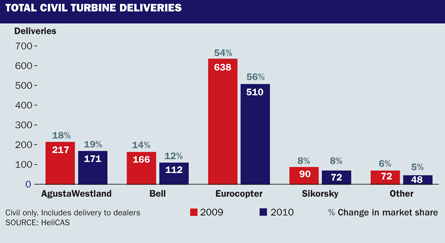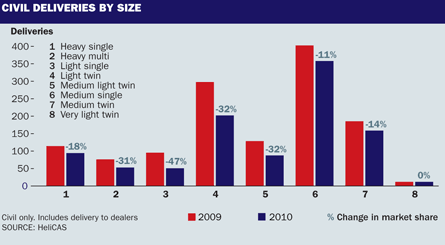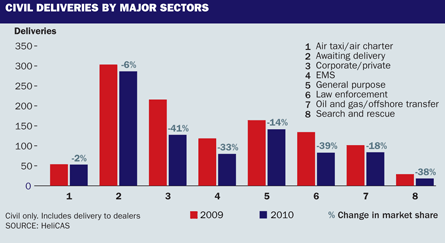Armed with a rising economy and a drive to succeed, today's rotorcraft industry stands ready to start reaping the fruits of its years-long self-critiquing labour.
With significant progress made or under way, the sector is poised to take its place among the best and brightest in the aerospace world, where innovation is king and safety is job number one. "I think we targeted what the real issues are," says Matt Zuccaro, president of the Helicopter Association International (HAI), the advocacy group that now includes 3,000 members and 90 international affiliates, of the industry's maturation during his five-plus years in the hot seat.
 |
|---|
© Eurocopter |
Those issues included a higher-than-desired accident rate for helicopters in general aviation operations, particularly for emergency medical services helicopters (see P30); noise concerns that marred the reputation of companies and threatened to restrict or eliminate necessary police, emergency and business aviation activities; a lack of advocacy in government circles and a dearth of communication among those in the industry.
SAVING GRACE
HAI hovers at the forefront of efforts internationally to analyse methodically the industry's myriad tendrils into the transport sector and to make improvements.
Zuccaro observes that rotorcraft perform more than 50 different missions, a variety that allowed operators to deploy their assets to alternate missions when the economy shut down their primary uses. "It's the saving grace of this industry," he says.
Proof that the industry is indeed rebounding is evident in the number of exhibitors registered for HAI's annual Heli-Expo exhibition in Orlando in Florida in the first week of March - up to an all-time high of 600 this year, from 570 in 2010. Flightglobal's HeliCAS database shows deliveries of turbine-powered helicopters by most manufacturers worldwide were down about 25% to 1,305 in 2010 compared with 2009, similar to the drop experienced in the business jet sector. Manufacturers expect flat or slightly increasing levels for 2011, with growth returning in 2012. The industry's diversity has also been a challenge when attempting to raise all participants to a higher level in terms of safety and image.
 |
|---|
 |
 |
That reality is what keeps Zuccaro and his top deputies on the road for outreach activities more than 50% of every year and has plunged the organisation headlong into the YouTube and Twitter generation. Top-shelf programmes include working with the Federal Aviation Administration and state and local authorities to set up safety-boosting automatic dependence surveillance - broadcast capabilities for air tour operators in Alaska and Hawaii, areas where no radar coverage is available, and continuing participation in the International Helicopter Safety Team (IHST).
HAI participated in getting ADS-B operational in the Gulf of Mexico, where full-time surveillance is now possible along with real-time weather reports - improvements which the FAA says has both increased safety and cut instrument flight rules weather delays.
As for IHST progress, Zuccaro says the industry is exceeding its waypoints for reducing the overall worldwide helicopter accident rate by 80% by 2016, the goal of the IHST when it was voluntarily established by the industry in 2005. "In no way do we claim HAI is responsible for that," he adds.
Last year, HAI brought together the four largest helicopter OEMs to sign an agreement supporting IHST safety initiatives. Zuccaro plans a similar signing with the emergency medical services industry at this year's HAI show.
Other HAI initiatives include promoting the use of safety management systems for pilots and technicians, in part to help workers decide when a mission is too dangerous too attempt. "We have to accept the fact that 'no' is an acceptable response," says Zuccaro. "Being better at deciding what [missions] we're going to do is where the magic is."
Helicopter pilot improvement requires better instructors, and HAI is working with the FAA to develop a helicopter-specific flight instructor renewal course, to be offered at weekend seminars and online. HAI also has an initiative with the FAA to sponsor a series of FAA Safety Team briefings for pilots and mechanics, three of which have been held in the USA.
RAISING THE SAFETY BAR
HAI is also planning to begin offering mission-specific safety accreditation reviews to helicopter operators under a joint effort with the international standard for business aircraft operations. Zuccaro says a draft of the accreditation programme, a code of audit-verified best practices in use largely by the fixed-wing business aviation community, will be presented at Heli-Expo. The programme is likely to be finalised by September and offered to operators next spring.
Manufacturers are playing a critical role in raising the safety bar in terms of product and culture, but also by supplying the improved pilot/machine interfaces or the pure adrenaline rush that comes with exciting new products. After a major research and development push during the past two years - a necessity during an economic down-cycle - new products were introduced and tested, and are on the verge of being revealed, both for the civil and military markets.
Eurocopter says this year it will emphasise "improving fleet safety with smaller operators", as well as in markets where it is "beginning to obtain a foothold". Over the next year it is to launch one new helicopter "for the expansion and modernisation" of its helicopter family, perform the first flight "of a major product upgrade" and certificate the EC175 heavy twin it is building in joint venture with China's Avicopter. The company also plans to validate the use of diesel engines for light helicopters and make further improvements to its noise- and vibration-reducing "bluecopter" technologies. Eurocopter chief executive Lutz Bertling expects the EADS subsidiary to deliver fewer helicopters in 2011 than in 2010, but has forecast that a more favourable mix of deliveries, in addition to a rise in services, would keep revenue at 2010 levels.
Tapping into the excitement Sikorsky generated when it flew its X2 advancing blade pusher demonstrator to 250kt (460km/h) in September, Eurocopter in December successfully achieved an interim speed milestone of 180kt for its X3 compound helicopter, a configuration Bertling says customers could first expect to see on an EC225 replacement in about six years' time. The company expects a maximum speed of about 220kt for the configuration.
INTRIGUING NEW X4 PLATFORM
Perhaps more intriguing is the company's new X4 platform, to be unveiled this year, perhaps at Heli-Expo. Bertling promises the AS365 Dauphin replacement will be "a revolutionary step forward in helicopter technology" and a "game changer" that introduces a "completely different" way of flying compared with today's helicopters. Sikorsky, meanwhile, has nearly finished its work with the X2, but the technology is being applied to two S-97 Raider prototypes the company is building over the next four years to test the advancing blade concept for a high-speed scout and attack helicopter for military applications.
Along with the Raider, Sikorsky is also readying for first flight of an all-electric S-300C-based helicopter called the Firefly, designed to remain aloft for only 15min but, more importantly, to prove various electric propulsion and control principles. As far as commercial prospects are concerned, Sikorsky executives say growth will return in 2012, partly driven by the start of deliveries of the company's new S-76D medium twin.
AgustaWestland has not been vocal about its ongoing research and technology efforts, aside from the introduction of a new AW169 4.5t class, 10-passenger Pratt & Whitney Canada PW210-powered twin at Farnborough in 2010.
The company has yet to reveal plans for the BA609 civil tiltrotor, a joint venture with Bell Helicopter. The company had expected to take full ownership of the project by mid-2010.
Bell made some intriguing news of its own in January when an internal newsletter revealed the existence of a new clean-sheet development programme called Magellan. Parent company Textron has confirmed that some of the increased research and development costs at Bell are for an "add-on" to an existing family of helicopters, presumably the Bell 429. Unlike Eurocopter and Sikorsky, Bell expects 2011 to be better than 2010 for deliveries, and 2012 even better. "We're encouraged by what we see in the industry," says Textron chief executive Scott Donnelly.
Source: Flight International













